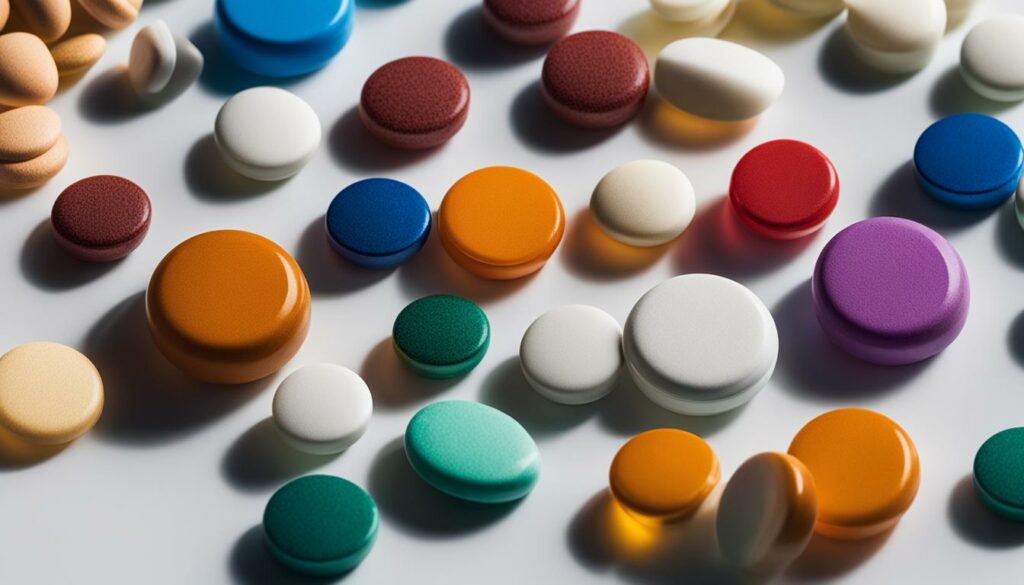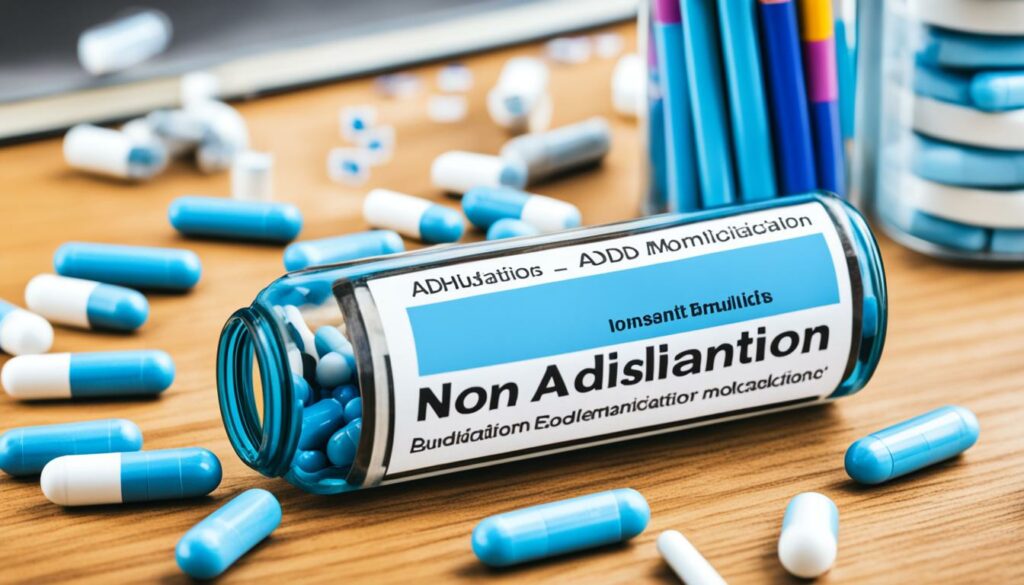Did you know that over 6.1 million children in the United States, between the ages of 2 and 17, have been diagnosed with ADHD?
ADHD medication plays a crucial role in helping individuals manage the symptoms of Attention Deficit Hyperactivity Disorder (ADHD). By increasing levels of key neurotransmitters in the brain, these medications improve attention span, reduce hyperactivity, and help control impulsive behavior.
However, like any medication, ADHD pills come with both benefits and potential side effects. It’s essential to understand the effectiveness, risks, and safety considerations before deciding on the best ADHD treatment option.
Key Takeaways:
- ADHD medication helps individuals with ADHD by increasing levels of neurotransmitters in the brain.
- There are various types of ADHD medications, including stimulants, non-stimulants, and occasionally antidepressants.
- ADHD medication is not a cure for the disorder but can help improve symptoms and overall functioning.
- Before starting ADHD medication, it’s important to consider other treatment options, such as behavior therapy.
- Working closely with healthcare providers can help ensure the safest and most effective use of ADHD medication.
What is ADHD Medication?
ADHD medication is a treatment option that helps individuals with ADHD (Attention Deficit Hyperactivity Disorder) manage their symptoms and improve their ability to focus, pay attention, and control their behavior. FDA-approved medications are available for both children and adults, offering relief and support in managing ADHD.
While ADHD medication does not cure the condition, it can significantly alleviate symptoms and enable individuals to function more effectively in their daily lives. Medication works by targeting the imbalance of neurotransmitters, such as dopamine and norepinephrine, in the brain, which are associated with ADHD.
With the help of medication, individuals with ADHD can improve their attention span, reduce hyperactivity, manage impulsive behavior, and better control executive functioning. It is important to note that the effectiveness of ADHD medication can vary from person to person, and finding the right medication and dosage may require some trial and error.
One of the key benefits of FDA-approved medications for ADHD is their ability to help children as young as 6 years old. This makes medication a viable option for pediatric ADHD treatment, providing relief and support for children who may struggle with focus, impulsivity, and hyperactivity.
Types of ADHD Medications
ADHD medications are available in different types, including stimulants, non-stimulants, and occasionally antidepressants. Each type of medication addresses unique needs and symptoms associated with ADHD.
Stimulants for ADHD
Stimulant medications are the most commonly prescribed treatment for ADHD. They work by increasing dopamine and norepinephrine levels in the brain, which helps improve attention, reduce hyperactivity, and control impulsivity. Examples of stimulant medications include:
- Ritalin (methylphenidate)
- Adderall (amphetamine)
- Focalin (dexmethylphenidate)
Stimulant medications are available in short-acting and long-acting formulations to meet individual needs. Short-acting stimulants typically last for a few hours, while long-acting stimulants provide extended coverage throughout the day.
Non-Stimulants for ADHD
Non-stimulant medications may be prescribed when stimulants are ineffective or result in intolerable side effects. While non-stimulants take longer to start working, they can help improve focus, attention, and impulse control. Some commonly prescribed non-stimulant ADHD medications include:
- Strattera (atomoxetine)
- Kapvay (clonidine)
- Intuniv (guanfacine)
Non-stimulant medications work differently from stimulants. Atomoxetine and viloxazine function as selective norepinephrine reuptake inhibitors, while clonidine and guanfacine belong to a class of medications called alpha-2 adrenergic agonists.
Antidepressants for ADHD
Antidepressant medications may occasionally be prescribed to individuals with ADHD who also have related mood disorders. These medications can help manage both ADHD symptoms and mood dysregulation. Examples of antidepressants used for ADHD treatment include:
- Wellbutrin (bupropion)
- Prozac (fluoxetine)
- Zoloft (sertraline)
It’s important to note that antidepressants for ADHD are typically used in combination with other ADHD medications and under the guidance of a healthcare professional.

This image visually represents the different types of ADHD medications discussed in this section.
Commonly Prescribed ADHD Medications
When it comes to treating ADHD, healthcare providers commonly prescribe a range of medications to help manage symptoms and improve daily functioning. These medications have undergone rigorous testing and have been approved by the U.S. Food and Drug Administration (FDA) to ensure their effectiveness and safety for ADHD treatment.
ADHD medications can be classified into two main categories: stimulants and non-stimulants. Stimulant medications are the most commonly prescribed type and include both brand-name and generic options. Non-stimulant medications are typically prescribed as an alternative for individuals who may not tolerate or respond to stimulant medications.
Brand-Name Stimulants
Brand-name stimulants are FDA-approved medications that help manage ADHD symptoms by increasing certain neurotransmitter levels in the brain. These medications are available in different forms and durations to suit individual needs:
| Medication | Duration | Form |
|---|---|---|
| Adderall | Short-acting (4-6 hours) | Immediate-release tablet |
| Ritalin | Intermediate-acting (4-6 hours) | Immediate-release tablet |
| Vyvanse | Long-acting (up to 14 hours) | Capsule or chewable tablet |
Non-Stimulant Medications
Non-stimulant medications are an alternative option for individuals who cannot tolerate or prefer not to take stimulant medications. These medications work differently from stimulants but can still effectively manage ADHD symptoms. Some common non-stimulant medications include:
- Atomoxetine: This selective norepinephrine reuptake inhibitor helps improve attention span and reduce impulsivity.
- Clonidine: Belonging to a class of medications called alpha-2 adrenergic agonists, clonidine can help manage impulsivity and hyperactivity.
- Guanfacine: Another alpha-2 adrenergic agonist, guanfacine can help improve attention span and reduce hyperactivity.
- Viloxazine: Also a selective norepinephrine reuptake inhibitor, viloxazine can help with concentration and impulse control.

It’s important to note that different individuals may respond differently to these medications, and healthcare providers will determine the most suitable medication based on an individual’s unique needs and medical history.
It’s essential to work closely with your healthcare provider to find the right medication, dose, and schedule that work best for you or your child. Open communication throughout the treatment process is key to maximizing the benefits of medication while minimizing potential side effects.
Considerations Before Starting ADHD Medication
When exploring treatment options for ADHD, medication is often an important consideration. However, it’s crucial to recognize that medication is not the only solution. Behavior therapy, in combination with medication, has been found to be more effective in managing ADHD symptoms.
Behavior therapy involves implementing specific strategies and techniques to address problematic behaviors associated with ADHD. It focuses on teaching individuals skills to improve their organization, time management, and social interactions. By working with a therapist or counselor, individuals can develop coping mechanisms and learn techniques to better manage their symptoms.
“Behavior therapy can be particularly useful for individuals who are not yet ready to start medication or prefer to explore non-pharmacological approaches.”
Before starting ADHD medication, it’s essential to weigh the available treatment options and consider behavior therapy as an alternative or complementary approach. Some individuals may prefer to try behavior therapy first or alongside medication to maximize the benefits of treatment.
In addition to considering treatment options, it’s important to prioritize safety when starting ADHD medication. Before initiating medication, individuals should discuss any underlying medical conditions, such as heart defects or hypertension, with their healthcare provider to ensure proper precautions are taken.
Regular monitoring is crucial to assess the effectiveness of medication and identify any potential side effects. Common side effects of ADHD medications include loss of appetite, irritability, and sleep disturbances, among others. By closely monitoring these potential side effects, healthcare professionals can adjust the medication regimen, dosage, or timing as needed to minimize any adverse effects.
| Considerations Before Starting ADHD Medication: |
|---|
| Explore behavior therapy as an alternative or complementary treatment option |
| Discuss any underlying medical conditions with healthcare provider for proper safety precautions |
| Monitor and report any potential side effects to healthcare provider for appropriate adjustments |
By carefully considering ADHD treatment options and prioritizing safety, individuals can make informed decisions about their treatment plan. Collaboration with healthcare professionals, open communication, and ongoing monitoring contribute to the successful management of ADHD symptoms.
Stimulant ADHD Medications
Stimulant ADHD medications are commonly prescribed to manage symptoms of attention deficit hyperactivity disorder (ADHD). These medications help improve focus, attention, and impulse control in individuals with ADHD. They come in different forms, including short-acting and long-acting stimulants.
Short-acting Stimulants
Short-acting stimulants are fast-acting and typically last around 3-4 hours. While they provide immediate symptom relief, they may cause the “crash” effect afterward. Common examples of short-acting stimulants include amphetamine (Adderall, Dexedrine) and methylphenidate (Ritalin, Focalin).
Intermediate and Long-acting Stimulants
Intermediate and long-acting stimulants offer a more sustained effect throughout the day, lasting between 6-16 hours. These medications provide a consistent level of symptom control and reduce the need for multiple doses. Some commonly prescribed intermediate and long-acting stimulants include:
- Amphetamine- extended-release (Adderall XR)
- Methylphenidate- extended-release (Ritalin LA, Concerta)
- Lisdexamfetamine (Vyvanse)
- Dexmethylphenidate (Focalin XR)
Long-acting stimulants are especially beneficial for individuals who require symptom relief throughout the school or workday.
Side Effects of Stimulant Medications
While stimulant medications can be effective in managing ADHD symptoms, they are not without potential side effects. Some common side effects of stimulant medications may include:
- Loss of appetite
- Upset stomach
- Restlessness
- Mood swings
- Headaches
- Increased heart rate
It’s essential to discuss potential side effects with healthcare providers and monitor their impact on daily functioning. Adjustments in medication type or dosage may be necessary to minimize side effects while maintaining symptom control.
| Stimulant Medication Type | Duration | Examples |
|---|---|---|
| Short-acting stimulants | Last around 3-4 hours | Amphetamine (Adderall, Dexedrine) Methylphenidate (Ritalin, Focalin) |
| Intermediate and long-acting stimulants | Last 6-16 hours | Amphetamine- extended-release (Adderall XR) Methylphenidate- extended-release (Ritalin LA, Concerta) Lisdexamfetamine (Vyvanse) Dexmethylphenidate (Focalin XR) |

Non-Stimulant ADHD Medications
Non-stimulant medications can be a suitable option for individuals with ADHD who may not respond well to stimulant medications or experience side effects. Here are some commonly prescribed non-stimulant ADHD medications:
| Medication | Brand Name | Class/Action |
|---|---|---|
| Atomoxetine | Strattera | Selective norepinephrine reuptake inhibitor |
| Clonidine | Kapvay | Alpha-2 adrenergic agonist |
| Guanfacine | Intuniv | Alpha-2 adrenergic agonist |
| Viloxazine | Qelbree | Selective norepinephrine reuptake inhibitor |
Atomoxetine and viloxazine work by selectively inhibiting the reuptake of norepinephrine, a neurotransmitter involved in attention and impulse control. These medications may help improve concentration and impulse regulation.
Guanfacine and clonidine belong to a class of medications called alpha-2 adrenergic agonists. Although primarily used to treat high blood pressure, these medications have shown effectiveness in managing hyperactivity and impulsivity in individuals with ADHD.
As with any medication, non-stimulant ADHD medications may have side effects. Common side effects include stomach upset, mood swings, headaches, dizziness, and sleepiness.

Conclusion
While ADHD medication can be a valuable tool in managing symptoms, it is important to remember that it is not a cure for ADHD. Collaborating closely with healthcare providers is essential to finding the right medication, dose, and schedule that works best for each individual. Additionally, adopting a multimodal treatment approach that combines medication with therapy, behavior changes, and skills training can greatly optimize ADHD management.
It is crucial for individuals and their families to prioritize informed decision-making when it comes to ADHD treatment options. Understanding the potential benefits and side effects of ADHD medications empowers individuals to make educated choices about their treatment journey. By staying well-informed, individuals can work with their healthcare team to develop a personalized treatment plan that aligns with their unique needs and goals.
Remember, managing ADHD is not a one-size-fits-all approach. Each person’s experience with ADHD is unique, and their treatment should be tailored accordingly. By considering the full range of treatment options, including medication, therapy, and behavior modifications, individuals with ADHD can enhance their daily functioning and improve their overall quality of life.
